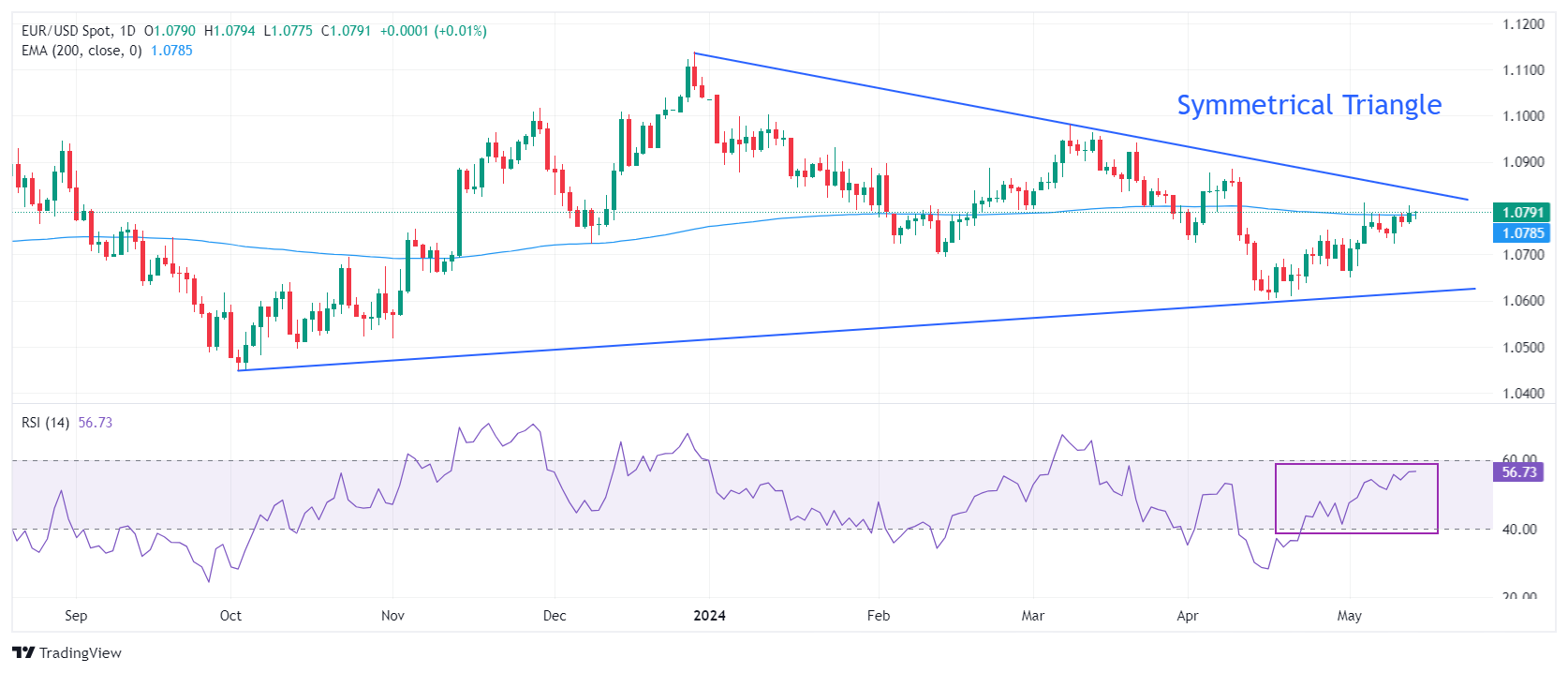- EUR/USD moves higher to 1.0800 as investors turn cautious ahead of key US inflation readings and Eurozone Q1 GDP data.
- Eurozone price index is on track to return to 2% as service inflation eases to 3.7%.
- The US inflation data will influence Fed rate-cut prospects for September.
EUR/USD rebounds to the round-level resistance of 1.0800 in Tuesday’s European session. The major currency pair extends its upside ahead of the release of the United States Consumer Price Index (CPI) for April and the Eurozone’s preliminary Q1 Gross Domestic Product (GDP) data, which will be published on Wednesday.
US consumer inflation data will significantly influence speculation for the Federal Reserve (Fed) rate cuts, which it is expected to begin from the September meeting. US CPI remained hotter than expected in the first quarter of the year due to tight labor market conditions and robust household spending. Therefore, investors will keenly focus on it as the continuation of the release of hot readings will force traders to pare bets for Fed rate cuts in September. Hot inflation reading will also offset the Fed rate-cut optimism built on easing labor market conditions.
Daily digest market movers: EUR/USD holds strength ahead of key data
- EUR/USD exhibits strength near the crucial resistance of 1.0800. The major currency pair moves inside Monday’s trading range as the US Dollar remains steady ahead of the release of producer and consumer inflation readings for April. The US Dollar Index (DXY), which tracks the Greenback’s value against six major currencies, trades steadily above the crucial support of 105.00.
- The US consumer inflation data will be the major event of the week, which is expected to soften. But before that, investors will focus on the Producer Price Index (PPI) data, which will be published at 12:30 GMT on Tuesday. Investors expect that the producer inflation will remain stubborn. Annual headline PPI is estimated to accelerate by 2.2% from the prior reading of 2.1%, with core readings growing steadily by 2.4%.
- On the other side of the Atlantic, investors await the preliminary Eurozone Q1 GDP, which is expected to have expanded at a steady rate. Quarterly and annualized GDP are projected to have grown stably by 0.3% and 0.4%, respectively. Upbeat GDP growth would provide relief to European Central Bank (ECB) policymakers, which are planning to start lowering borrowing rates from the June meeting.
- Price pressures in the Eurozone economy are on course to return to the desired rate of 2% as the service inflation, which remained consistent at 4% in the November-March period, declined sharply to 3.7% in April. Financial markets have anticipated that the ECB will reduce interest rates by 70 basis points (bps) this year.
Technical Analysis: EUR/USD holds gains near 1.0800
EUR/USD trades close to the round-level resistance of 1.0800. The 200-day Exponential Moving Average (EMA) near 1.0800 is acting as a strong barrier for Euro bulls.
Even though, the major currency pair is on course towards the downward-sloping border of the Symmetrical Triangle pattern formed on a daily timeframe, which is plotted from the December 28 high around 1.1140. The upward-sloping border of the triangle pattern is marked from the October 3 low at 1.0448. The Symmetrical Triangle formation exhibits a sharp volatility contraction.
The 14-period Relative Strength Index (RSI) oscillates inside the 40.00-60.00 range, suggesting indecisiveness among market participants.
Economic Indicator
Producer Price Index ex Food & Energy (YoY)
The Producer Price Index ex Food & energy released by the Bureau of Labor statistics, Department of Labor measures the average changes in prices in primary markets of the US by producers of commodities in all states of processing. Those volatile products such as food and energy are excluded in order to capture an accurate calculation. Generally speaking, a high reading is seen as positive (or bullish) for the USD, whereas a low reading is seen as negative (or bearish).
Read more.
Credit: Source link




